6 key areas to consider when planning farm diversification
Diversification ventures often require a quite different set of skills and resources than for the farm business. Jonathan Riley asked a range of advisers for top tips on six key areas in developing a project.
The best diversifications complement the existing farm business by improving cashflow, adding profit and cutting volatility. But ventures beyond straight farming can drain time and money from the core business.
See also: Business clinic: Diversification advice for tenants
The key is to think ahead and look at every aspect of the project before making a commitment – and seek advice.

© Tim Scrivener
Planning
One of the main steps is to know the planning options. A diversification project that uses existing farm buildings is likely to require full planning permission for change of use.
However, since 2015, legislation changes make it possible to convert agricultural buildings for some commercial purposes under Permitted Development Rights (PDR).
Care is needed here as there are important restrictions which, if overlooked, could necessitate a full application and may risk rejection.
Development cannot begin until the local planning authority has determined in writing whether prior approval is required.
Most importantly, while change of use may be achievable under PDR, any physical changes that alter the appearance of the building will require full planning permission.
If the project does not fall into permitted development then it is important to ensure the site can take the level of development proposed and that designations such as green belt and areas of outstanding natural beauty do not defeat the project before it is started.
The traffic created by the development will be a major consideration in gaining permission and a traffic survey may be needed.
Planning pointers
- Don’t underestimate timescales. It can take several months to produce the required documentation then eight weeks in planning once the application has been validated.
- Don’t underestimate submission costs. Typically, projects may require ecological, structural and contamination surveys, plus flood risk and air quality/noise surveys. This is in addition to CAD drawings, application forms and design and access statements.
- Timing of surveys is critical. For example, bat surveys must be undertaken between April and September.
- Planning fees for non-agricultural buildings are high, at £385 per 75sq/m
- Understanding planning policy is key, Policies are frequently updated so make sure you use the most recent one.
Legal issues
Consider the appropriate business structure for the new enterprise. If the diversification project falls outside the activities of the farming entity, should it have its own vehicle, what should that be – sole trader, partnership, limited company – and how should it fit with the farming business to make land and buildings available for its use?
Considering whether to trade as a partnership or limited company may depend on who is involved in the business and whether there is any major risk.
In many food processing ventures a limited company is set up to prevent any major health risks rebounding on the original farming business.
Opting for a limited company also means employees can be motivated though tax-efficient share options as opposed to higher salaries.
Where two or more people agree to run a business together with a view to a profit, whether a formal written agreement exists or not, a partnership may exist by law.
A partnership has advantages over a limited liability company, the main ones being:
- the lack of formality (agreement can be oral, implied by conduct or written)
- there are no formal reporting and disclosure requirements
- partners can claim tax relief for start-up losses
A partnership should also always have an agreement specifying who is responsible for what and, most importantly, how the business may be wound up.
Legal tips
- It pays to involve a solicitor in drawing up any agreement
- Check title deeds for restrictive covenants, which may prevent certain activities, constructions or uses of land or buildings
- Obtain the prior consent of any lender
- Check the necessary planning consents are in place
- Write wills and maybe cross-insure individuals against death/debts being repayable
- Check and observe health and safety and other regulatory requirements
Staff and training

© ING Image
If employing staff in a new enterprise, the National Minimum Wage (NMW) and the National Living Wage (NLW) requirements need to be understood.
It’s important to not overlook an employer’s responsibilities to provide workplace pensions.
Consider whether staff are seasonal workers, workers or employees. Individuals providing services will typically be employees, workers or temporary agency workers. This terminology matters because a person has different rights, depending on how their work status is classified.
A written contract is required by law within two months of an employee’s start date and a consultation is required if changing staff contractual terms and conditions.
A failure to consult and imposing changes could result in a redundancy and/or constructive/unfair dismissal claim.
Staff pointers
- Carefully assess how much staff resource will be needed, keep a holiday planner and ensure adequate back-up to cover illness
- Be aware of forthcoming changes to hourly rates, which will affect profitability
- Ensure staff are trained to be well-presented, enthusiastic and polite
- Ensure the minimum wage is paid on hourly rates and/or paying correct holiday pay if any new role involves overtime at an enhanced rate of pay
Tax
Agricultural Property Relief (APR) allows an estate to pass to the next generation tax-free in many cases. However, diversification can prevent this valuable relief from being applied.
Activities such as solar, wind farms and yurt rental invalidate the relief. Business Property Relief (BPR) could be available instead, allowing assets to pass tax-free but planning is needed to ensure HMRC conditions are met.
If losses occur in the first year of a new venture, the correct structure can result in tax refunds.
Business plans should be drawn up and shown to accountants and other interested parties. This will help check and amend the plans before taking any decisions that could affect the tax position and before approaching banks for finance.
In tax planning terms, both income and longer-term capital gains and inheritance taxes need to be considered.
Tax tips
- Always seek advice from an accountant/tax adviser at the outset
- Most diversification projects involve investment assets (such as land let for renewable energy projects), which do not attract BPR or APR
- Consider bringing the diversification project into the farming partnership. If farming predominates in the partnership then BPR may be available on all assets within it, including the diversification.
Marketing
It is essential to establish a brand and image that represents the ethos of the business.
A good website and social media can have a big effect, while focused advertising is important to make people aware of what is on offer.
The new venture is likely to need a very different approach to that for sales of primary farm produce, so consider the challenges of seasonality, perishability and stock control.
This can also have huge implications for cashflow, which may be very different to that of the farm and this needs to be considered in the planning.
Marketing pointers
- Ensure the logo and literature are cohesive and reflect what the business does or sells that make it different
- Review it from the customer’s perspective
- Have a professional website and video (if used)
- Put aside time – at least weekly – to update social media
- Keep customers informed with targeted emails, loyalty schemes and offers
Financial planning

© ING Image
Detailed business plans must be presented to the bank. Market research for the project is important to assess whether the market size is available locally and the standard and quality of local competition. By doing this the risks become more obvious.
This all needs to be turned into a financial plan that highlights the profitability and cashflow, which can be problematic when starting new ventures.
Cashflow also needs to be factored in when accounting for voids if the venture involves letting or a B&B, for example.
Draw up a complete list of all the main expenditure and then break it down into its constituent parts and price these up individually.
Consider timing of expenditure outlay and then at the end build in a 7.5-10% contingency allowance for overspend.
Most projects go over budget because they have not been properly planned. Always break items down in detail to avoid having to go back to the bank for extra funding.
Having done the financial figures, stress-test the budgets with a higher interest rate and rigorous analysis, i.e what happens if yields or margins change by 5% or unit prices change by 10%. This will establish the break even points.
Financial tips
- Shop around to find the best finance deal
- Securing the correct funding – peer-to-peer, traditional debt or family money – all require scrutiny of the terms and conditions
- For banks and public funding, produce a detailed business plan including realistic cash flow projections over three years
- For farm diversification, investigate the Rural Development Plan for England opportunities. This includes local Leader funding and the national Growth Programme.
- Don’t underestimate how long it takes to submit an RDPE application – run it alongside and in the same timescale as planning
- Don’t try to get funding for every item. Stick to the big-ticket items only.
- Include three identical quotes. For complex build projects produce a detailed specification to ensure quotes are the same.
- Grants are paid in arrears so ensure the cashflow is sustained through the build.
Expert sources
Acorus rural property consultants
Brian Barrow – planning director
Bidwells property consultants
Ian Ashbridge – partner
Clarke Willmott Solicitors
Rod Lloyd-Jones – partner
David Maddock – partner
Kate Gardner – partner
Farm Consultancy Group
Ian Browne – consultant
JMH Farming & Renewables
James Miles-Hobbs – director
Oury Clark solicitors and accountants
Antony Smith – tax manager
Simon J Walsh – associate solicitor
Rural Futures development consultants
John Welbank – management consultant
